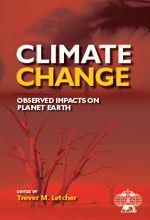|
|
Vol.
31 No. 5
September-October 2009
Climate Change: Observed Impacts on Planet Earth
Edited by Trevor M. Letcher
Elsevier, 2009
[ISBN: 044453301X; ISBN 13: 9780444533012]
Climate Change can be considered as a sequel to Trevor Letcher’s recent book Future Energy (published in 2008, also by Elsevier). The two are inexorably linked.
 |
The book is divided into 25 chapters, each one written by an expert in the field. The first five chapters focus on the possible causes of climate change, while in particular the first chapter deals with the possible effects of anthropogenic greenhouse gases. Chapter six discusses the geological history of climate change, and puts the whole idea of climate change into perspective. The remaining 19 chapters focus on a variety of global changes brought about by climate change. These include detailed scientific observations on weather patterns; plants and plant pathogens; lichens; bird, insect, and animal ecology; sea temperature and ocean currents; rising sea levels; and coastal erosion and ice sheets. If there ever was doubt about whether global and climate changes are taking place, these chapters may help put such thinking to rest.
This book supports the work done by the Intergovernmental Panel on Climate Change through experimental evidence. There has been no speculation, through computer modeling, at predicting possible future scenarios. The book is a scientific presentation of the facts surrounding climate change and no attempt has been made to offer solutions, although the basic nature of the problem is obvious; the burning of oil, coal, and gas is causing a significant rise in atmospheric carbon dioxide, water vapor, nitrogen oxides, and particulate matter—all of which influence our climate. This book should have a strong influence on deciding our future energy options.
IUPAC supports the book, through its Chemistry and the Environment Division. IUPAC’s adherence to the International System of Quantities is reflected in the book, with the use of SI units wherever possible.
Climate Change is a source book and guide and is written, not only for students and researchers and their professors, but for decision makers in government and in industry, journalists and editors, corporate leaders, and all interested people who wish for a balanced, scientific, and honest look at this major problem facing us.
www.iupac.org/web/ins/2007-050-2-600
Page last modified 14 September 2009.
Copyright © 2003-2009 International Union of Pure and Applied Chemistry.
Questions regarding the website, please contact [email protected]
|